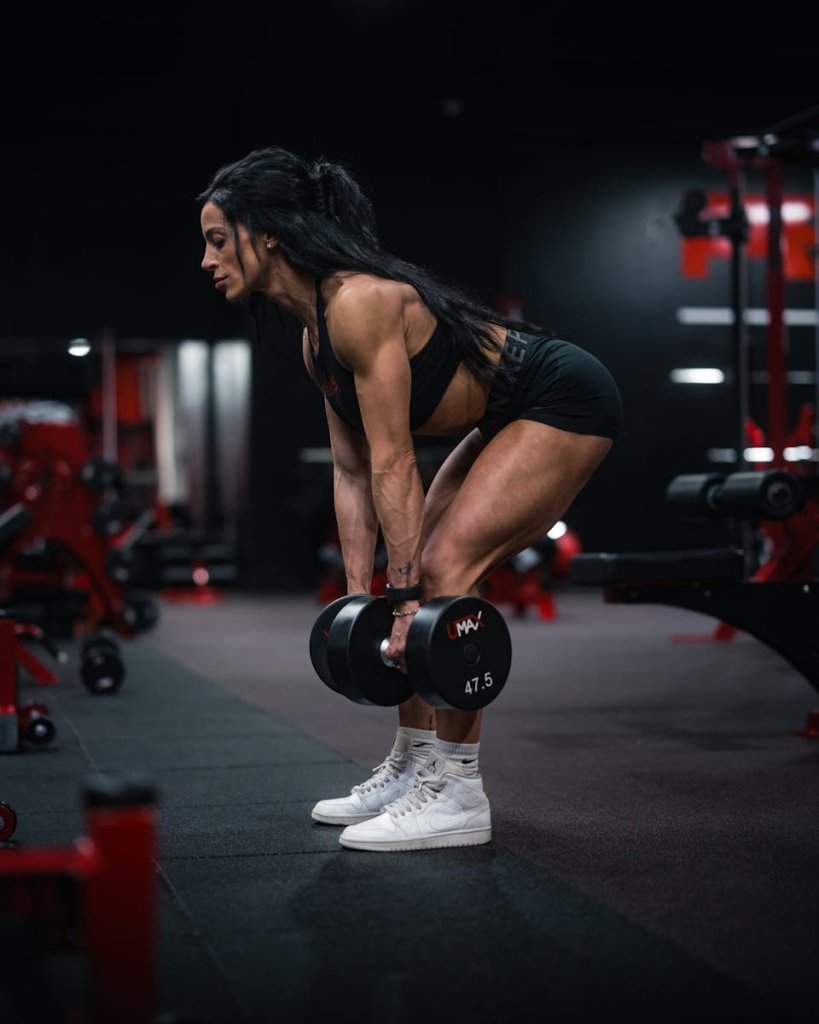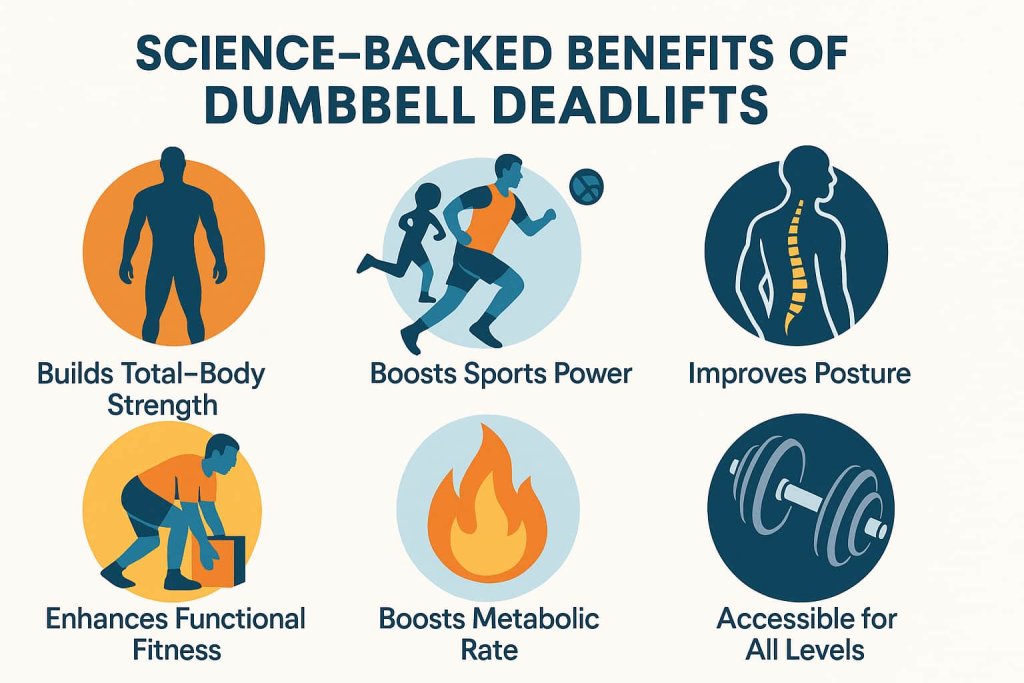The dumbbell deadlift is one of the most effective full-body strength training moves, targeting your hamstrings, glutes, lower back, and core while also improving balance and posture. Unlike the barbell deadlift, this version is easier to learn, safer for beginners, and requires minimal equipment—just a pair of dumbbells.

Learning correct form is crucial because poor execution can lead to back strain or wasted effort. This guide will cover step-by-step technique, muscle activation, variations for all fitness levels, benefits backed by research, common mistakes, safer alternatives, and trainer-approved tips so you can deadlift confidently and effectively.
How to Do the Dumbbell Deadlift: Step-by-Step Guide
The dumbbell deadlift may look simple, but it’s more than just “picking things up.” It’s about hip hinging—a functional movement pattern used in daily life when lifting grocery bags, moving boxes, or picking up your kids.
1. Setup
- Feet Position: Stand with feet hip-width apart, toes pointing forward or slightly out.
- Grip: Hold a dumbbell in each hand with a neutral grip (palms facing your thighs).
- Posture: Roll your shoulders back and down to engage your upper back.
- Core Engagement: Brace your abs as if preparing for a punch—this protects your spine.
Trainer Tip: Imagine there’s a string pulling the crown of your head toward the ceiling. This will naturally lengthen your spine.
2. Lowering Phase (The Hinge)
- Push your hips backward (not down like a squat).
- Maintain a slight knee bend—enough to relieve tension in the hamstrings but not so much that it turns into a squat.
- Keep the dumbbells close to your legs, sliding them down toward your shins.
- Lower until your torso is almost parallel to the floor or until you feel a good hamstring stretch.
Common Cue: Think about “closing a car door with your hips” instead of bending at the knees.
3. Lifting Phase
- Press your heels into the floor.
- Drive your hips forward, squeezing your glutes at the top.
- Keep your spine neutral—avoid leaning back or overextending.
Pro Tip: Pause for one second at the top to reinforce glute activation.
Muscles Worked in the Dumbbell Deadlift
The dumbbell deadlift is a compound exercise, meaning it engages multiple muscle groups at once.
Primary Movers:
- Hamstrings – Control the lowering phase and power the lift.
- Gluteus Maximus – Main driver in hip extension.
- Erector Spinae – Stabilizes the spine during movement.
Secondary Muscles:
- Lats and Traps – Keep the back tight and shoulders stable.
- Rhomboids – Retract the shoulder blades.
- Forearms and Grip Muscles – Hold the dumbbells securely.
- Core Muscles (Abs, Obliques) – Maintain spinal stability.
Research Insight: A 2023 study in the Journal of Strength and Conditioning Research found that hip-hinge movements like the deadlift significantly improve posterior chain strength, which is directly linked to sprint speed and jumping ability.
Science-Backed Benefits

- Builds Total-Body Strength
- Works nearly every muscle from head to toe.
- Boosts power for sports like sprinting, basketball, and football.
- Improves Posture & Reduces Back Pain
- Strengthens spinal erectors and postural muscles, counteracting hours of sitting.
- Enhances Functional Fitness
- Mimics real-world lifting patterns, helping prevent injury during everyday activities.
- Boosts Metabolic Rate
- Large muscle recruitment increases calorie burn during and after the workout.
- Accessible for All Levels
- Easy to scale up or down—choose light weights to learn form or heavy weights for strength gains.
Variations for Every Fitness Level
When it comes to dumbbell deadlifts, there’s no one-size-fits-all approach. Your strength level, mobility, and training goals determine which variation works best for you. Below are the most effective dumbbell deadlift variations, each targeting specific muscles and benefits.
1. Romanian Dumbbell Deadlift (RDL)
How it works:
The Romanian Dumbbell Deadlift starts from a standing position with the dumbbells held in front of your thighs. You lower the weights by pushing your hips back, keeping a slight bend in your knees, and stopping once your hamstrings feel stretched—often before the dumbbells touch the floor.
Benefits:
- Prioritizes hamstring and glute hypertrophy (muscle growth).
- Keeps tension on the posterior chain throughout the movement.
- Less lower-back strain compared to conventional deadlifts.
Trainer Tips:
- Keep your chest proud and shoulders pulled back.
- Lower slowly (about 3 seconds) to increase time under tension.
- Avoid letting knees bend excessively—this isn’t a squat.
Real-World Example:
Bodybuilders and athletes use RDLs to build strong hamstrings for sprinting, jumping, and reducing injury risk.
2. Stiff-Leg Dumbbell Deadlift
How it works:
This version uses minimal knee bend, which shifts more work to the hamstrings and spinal erectors (lower back muscles).
Benefits:
- Greater hamstring isolation.
- Builds lower-back strength for powerlifters and wrestlers.
- Improves hamstring flexibility over time.
Trainer Tips:
- Start with lighter weights until your flexibility allows for proper form.
- Don’t round your back—think about sticking your butt out.
- Breathe in before lowering to brace your core.
Who Should Try:
Experienced lifters with good mobility who want to strengthen their posterior chain without heavy squats.
3. Single-Leg Dumbbell Deadlift
How it works:
You hold a dumbbell in one or both hands while hinging forward on one leg, keeping the other leg extended behind you for balance.
Benefits:
- Improves balance, stability, and core engagement.
- Corrects muscle imbalances between legs.
- Builds functional strength for sports.
Trainer Tips:
- Focus your eyes on a fixed spot to maintain balance.
- Start with no weight to master the movement before adding load.
- Slightly bend the standing knee to avoid strain.
Example:
Athletes like runners and hockey players use single-leg RDLs to improve stability and power transfer in sport-specific movements.
4. Suitcase Deadlift
How it works:
Hold one dumbbell at your side like a suitcase, hinge at your hips, and stand tall again.
Benefits:
- Builds anti-rotation core stability, preventing your torso from twisting.
- Strengthens grip and forearm muscles.
- Adds a functional carryover to real-life lifting tasks.
Trainer Tips:
- Keep shoulders level; avoid leaning toward the dumbbell.
- Engage your obliques to resist rotation.
- Perform equal reps on each side.
Real-World Example:
Great for workers or athletes who lift uneven loads, like firefighters or movers.
5. Deficit Dumbbell Deadlift
How it works:
Stand on a small platform or weight plate, which increases the range of motion and challenges flexibility.
Benefits:
- Improves hip and hamstring mobility.
- Builds strength from a deeper hinge position.
- Transfers well to conventional deadlifts and Olympic lifts.
Trainer Tips:
- Only increase deficit height gradually to avoid overstretching.
- Maintain a strong brace to protect your spine.
- Use lighter weights until you’re comfortable with the range.
Example:
Weightlifters use deficit training to boost starting strength in clean & jerk pulls.
Common Mistakes and How to Fix Them
Even experienced lifters make form errors during dumbbell deadlifts. Here’s how to correct them:
Rounding the Back
- Why it’s bad: Places excessive strain on spinal discs.
- Fix: Keep a neutral spine by engaging your core and retracting your shoulder blades. Use a mirror for feedback.
Squatting Instead of Hinging
- Why it’s bad: Turns the exercise into a squat, reducing hamstring activation.
- Fix: Push hips back, not down. Practice the hip-hinge pattern with no weight before loading.
Letting Dumbbells Drift Forward
- Why it’s bad: Increases lower-back stress and reduces efficiency.
- Fix: Keep weights close to your shins throughout the lift. Imagine “shaving your legs” with the dumbbells.
Jerking the Weight Up
- Why it’s bad: Can cause muscle strains and break form.
- Fix: Lift in a controlled manner, exhaling as you stand tall.
Best Alternatives to the Dumbbell Deadlift
If you want variety or need to work around equipment limitations, try these effective substitutes:
Barbell Deadlift
- Allows heavier loads for maximum strength progression.
- Great for athletes building total-body power.
Trap-Bar Deadlift
- Reduces spinal loading due to neutral grip.
- Ideal for athletes and beginners wanting safer pulling mechanics.
Kettlebell Deadlift
- Perfect for beginners learning the hip hinge.
- Requires minimal equipment and space.
Hip Thrusts
- Glute-focused movement with minimal lower-back stress.
- Supported by EMG studies (Contreras, 2020) as one of the highest glute-activating exercises.
Who Should Do It
- Beginners learning hinge mechanics.
- Athletes looking to improve power and stability.
- People training at home with limited equipment.
- Avoid If – You have active lower-back injuries (consult a physiotherapist first).
Trainer Tips for Maximum Results
- Start Light, Perfect Form: Technique before load.
- Focus on Breathing: Inhale on the way down, exhale as you stand up.
- Use a Mirror: Check alignment and hip hinge.
- Progress Slowly: Add weight once you can maintain form for 3 sets of 10–12 reps.
FAQs
Q: How heavy should I go for dumbbell deadlifts?
A: Start light (10–20 lbs each hand) and increase once you can complete sets without form breakdown.
Q: Should I touch the dumbbells to the floor?
A: Only if you can maintain a flat back. Otherwise, stop at mid-shin level.
Q: Are they safe for my lower back?
A: Yes—if performed with proper form and core engagement.
Conclusion
The dumbbell deadlift is a versatile, beginner-friendly, and highly effective move for building lower-body and core strength, improving posture, and boosting overall fitness. Whether you’re training at home or in the gym, mastering this exercise will pay dividends in both performance and injury prevention.
